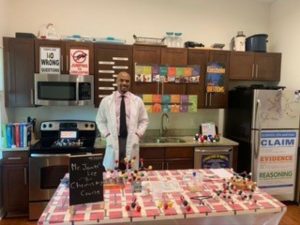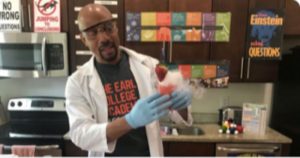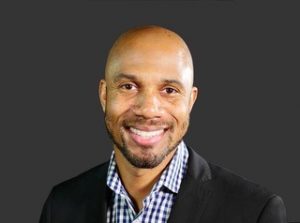I am Jonte Lee, chemistry and physics teacher in the Early College Academy at Calvin Coolidge High School, located in the DC Public Schools District. I enjoy teaching; I love teaching. Daily interactions with my students are a joy. When I started this academic school year, I had no idea it would end like this. This year was filled with happiness, sadness, enthusiasm, weariness, achievement, disappointment, and accomplishments. The academic year 2019 – 2020 will be one I would never forget.
January 2020: I first heard of the coronavirus. Honestly, I didn’t put much thought into it. The media was giving mixed reports on its severity, and the virus has not reached the United States at the time. I was not worried.
February 2020: The news was reporting the deaths and the spread of the virus around the world. Some reports downplayed the effects of the virus, and some did not. I was not concerned.
March 2020: The number of people impacted by COVID 19 was terrifying. States started to report their first cases. School districts began to close. Hospitals were being overwhelmed. I was scared. Teachers were given the following calendar:
- March 13, 2020: Students’ last day of school.
- March 16, 2020: Teachers will report to school and prepare lesson plans for distance learning.
- March 17, 2020, to March 23, 2020: Spring break. This was moved up from April.
- March 24, 2020, to March 31, 2020: Students will participate in learning from home.
- April 1, 2020: Teachers and students will report back to the school.
My first thoughts belonged to my students. I was worried about their safety and health. School is not only a place where students go to receive knowledge but, for some, a place where they can escape a dangerous situation at home or a place where they can get a hot, nutritious meal.
I was concerned about their family members, and, if someone had the coronavirus, how would that impact the students. So many questions were racing through my mind. I felt that I had to be strong for my students, so I wished them well and informed them that I would be in contact over email and text messaging with instructions. I wasn’t concerned about school assignments.
March 16, 2020: Teachers reported to school to plan for distance learning. It was on this day that I realized one of my responsibilities as a teacher. I must be a point of consistency for my students. Consistency is essential because it provides the young scholars with a mental anchor in a time of an unprecedented amount of change. With only hours left, I packed up as many items and chemistry equipment from my classroom as I could carry. I knew that we were going to be doing some form of online teaching, and I wanted my students to see a familiar place when they logged in online. At the time, I didn’t know what I was going to do it, but I knew I was on to something.
March 20, 2020: It was announced that students and teachers would not return to school until April 27. After this announcement, I made sure to check on every one of my students and their families. I also checked in on my family. My family lives in New Orleans, Louisiana, and New Orleans was an area struck by the coronavirus in high numbers. Around this time, I received word that my 75-year old aunt contracted the coronavirus. I was frightened. My mind was overwhelmed with thoughts. I couldn’t sleep or eat. I live in Washington, DC, and I wanted to be there with my family, but I couldn’t. To calm myself, I did the only thing I knew to do. I worked. As I provided consistency to my students, my work provided consistency to me.
March 31, 2020: My principal asked me to teach a live lesson on Instagram, and I agreed. I transformed my kitchen into a chemistry classroom. I was excited by the idea of teaching a class on social media. It was something I never did before. I was nervous about wondering how my students would receive a chemistry lesson on social media. This provided a distraction from worrying about my aunt.
April 3, 2020: I went live on Instagram. My lesson was titled “Chemistry of Monsters.†It was a hit!!! The students enjoyed the lesson and asked me to do more on Instagram. I felt a jolt of energy. That same energy I get when teaching students face-to-face. I decided to do a lesson once a week, and each week, more and more students tuned in. I had something to look forward to.
 April 15, 2020: My aunt made a full recovery. I cannot describe the feeling of relief. I continued to do the Instagram lessons in addition to other teaching methods to engage with my students.
April 15, 2020: My aunt made a full recovery. I cannot describe the feeling of relief. I continued to do the Instagram lessons in addition to other teaching methods to engage with my students.
April 17, 2020: Schools would remain closed until May 28, and the school year will be shortened. The feeling of excitement was marred with sadness. Even though I knew that all my students were okay, I was sad because I wouldn’t get a chance see them. A teacher needs to see their students because it gives assurance that they are genuinely okay. I knew my students were healthy, but what about their mental state? Besides, I wouldn’t get the chance to say goodbye and give them good wishes and advice for the next academic year. The end of the year goodbye is my closing out tradition. It wouldn’t be the same performing it online.
April 18, 2020, to Present: The live Instagram lessons exploded in popularity. My students told their friends, and so on, and I have parents, teachers, and students, logging in from all parts of the country. Social media has allowed me to become a community teacher that is not bound by four walls.

This pandemic has fortified several things: Four walls do not limit a teacher. We can teach anywhere and anytime. Teachers do not teach to the brain of the student but the whole student. We interact with their past, present, and future experiences. Teachers provide stability in their students’ lives. Teachers have a deep investment in the success of the student. Students want to learn, grow, and achieve greatness, even during difficult times, and this is the part where we come in as teachers.
 Mr. Jonte’ Lee is a community teacher and is willing to help any student that is in need of learning. Mr. Lee is willing to be a thought partner to parents and teachers during this pandemic. Mr. Lee can be reached as @JonteRlee on Instagram and Twitter!
Mr. Jonte’ Lee is a community teacher and is willing to help any student that is in need of learning. Mr. Lee is willing to be a thought partner to parents and teachers during this pandemic. Mr. Lee can be reached as @JonteRlee on Instagram and Twitter!
Mr. Jonte Lee has been teaching STEM in DC Public Schools for eight years. Before becoming a high school teacher, he worked in the corporate sector as a marketing specialist. His first call to teaching was when he volunteered for the Big Brother Big Sister program while working in the private sector. There he would read to his little brother twice a week. He liked it so much that he sought out to become a teacher. He first taught college in the school of business part-time while still working in corporate America. He discovered the joy of teaching and wanted to do it full time. It was through Ready To Teach, an alternative teaching certification program, at Howard University that he earned his teaching license. Through teaching, he found his life’s passion. He cannot see myself doing anything else. He enjoys making meaningful connections with students and pushing them academically forward. Hus greatest joy is seeing them grapple and learn a concept.



